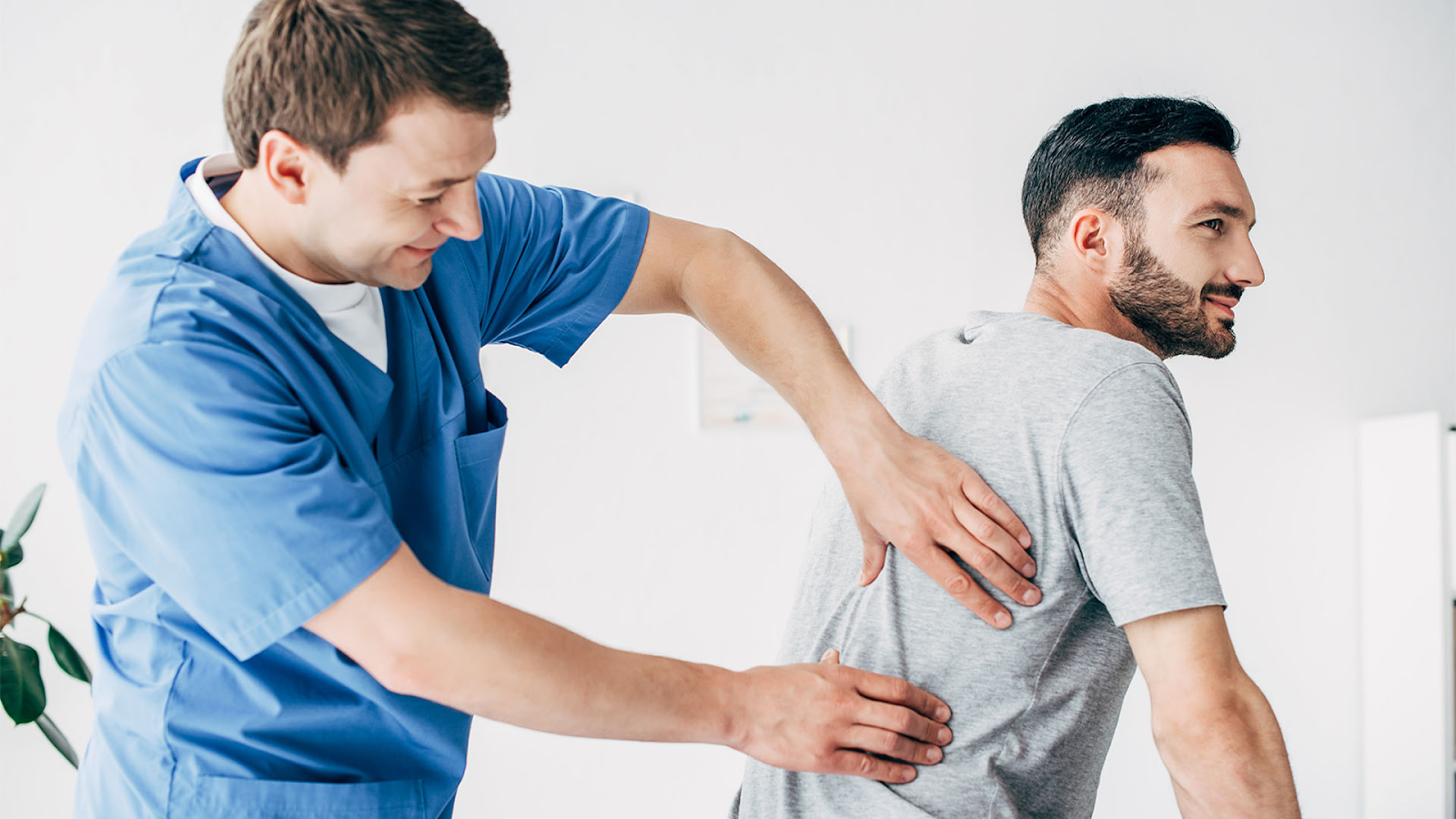
by Revive Chiropractic | Jun 17, 2025 | Blog
Posture is often overlooked, but it plays a significant role in our overall health. While many people only associate poor posture with occasional discomfort or pain, its effects go far beyond that. Poor posture can lead to a range of issues, including reduced mobility, lower energy levels, and even impact your internal organs. Over time, it can contribute to chronic conditions such as spinal misalignment, digestive issues, and increased stress on joints and muscles.
When the spine is out of alignment, it can restrict nerve function and impede communication between your brain and body, leading to muscle tension, headaches, and reduced mobility. Additionally, poor posture can compress your lungs and diaphragm, affecting your breathing and digestion. This can also contribute to fatigue and lower energy levels.
Chiropractic care is an effective way to address poor posture. By realigning the spine and improving nerve function, chiropractic adjustments can help alleviate pain, enhance mobility, and support overall health. Beyond physical benefits, improving posture can also boost mental well-being by reducing stress and improving focus.
Taking steps to improve posture is essential for long-term health. With proper care and awareness, you can avoid the hidden consequences of poor posture and improve your quality of life.
The Science Behind Posture and Pain

Before we explore the consequences of poor posture, it’s important to understand what happens to your body when you maintain incorrect alignment.
Your spine is designed to support your body in an upright position, with natural curves that help distribute weight evenly and maintain balance. These curves allow the spine to absorb shock and protect your internal organs. However, when you slouch, lean forward, or adopt an unnatural posture, you place undue strain on muscles, ligaments, and joints. This misalignment forces your body to compensate, which can cause these structures to become overstretched, weakened, or fatigued over time.
The result is more than just short-term discomfort. Poor posture disrupts your body’s ability to function efficiently. For example, slouching can lead to muscle imbalances, causing some muscles to become tight and others weak. This imbalance can affect your flexibility, strength, and movement. Additionally, it can lead to issues such as pinched nerves, headaches, and lower back pain.
Over time, poor posture may also impact your breathing, digestion, and circulation. Your organs can become compressed, and the strain on your spine and surrounding tissues can contribute to chronic conditions. By recognizing the underlying causes of poor posture, you can begin to address and correct it before these long-term effects take hold.
How Poor Posture Affects Your Body:

Spinal Health
The spine, when misaligned, can lead to a host of musculoskeletal issues. The most common problems include chronic back and neck pain, herniated discs, and reduced spinal flexibility. Poor posture disrupts the natural curves of the spine, causing compression on the discs and misalignment of the vertebrae.
Nerve Function
Misalignments in the spine can interfere with nerve function. The spinal cord is the primary communication route between the brain and the rest of the body. When your posture puts pressure on the spinal cord or nerves, it can cause pain, tingling, or numbness in other parts of your body. This is often referred to as radiculopathy or referred pain.
Muscle Fatigue and Imbalance
Poor posture places additional stress on muscles, leading to overuse and fatigue. For example, slouching causes the muscles in the lower back to work harder, while your abdominal muscles weaken due to a lack of engagement. Over time, this creates muscle imbalances that can lead to pain, stiffness, and decreased range of motion.
Joint Degeneration
Over time, improper posture can lead to degenerative joint diseases like osteoarthritis. This happens because the joints are being used improperly, causing wear and tear on the cartilage. Misalignments can lead to uneven pressure distribution, which accelerates joint degeneration and increases the risk of early-onset arthritis.
Breathing and Circulation
Poor posture, especially slouching or hunching forward, can compress your lungs and diaphragm. This decreases lung capacity, making it harder to breathe deeply. Shallow breathing reduces oxygen flow to your brain and muscles, which can cause fatigue, headaches, and even decreased cognitive function.
More Than Just Physical Pain: The Emotional and Mental Toll of Poor Posture

While poor posture is often linked to back pain, its effects extend beyond the physical realm, influencing your psychological and emotional well-being. Research has shown that the way you carry yourself can significantly impact how you feel and how others perceive you.
Poor posture, such as slouching or hunching, can make you appear less confident and more passive. This can affect your interactions with others, leading to feelings of insecurity or even anxiety. On a psychological level, maintaining a slouched posture can trigger a sense of defeat or low energy, reinforcing negative emotions. This is because body language plays a crucial role in how we express and interpret our mental state. When you hold yourself in an open, upright posture, it signals confidence and positivity, which can boost your mood and self-esteem.
Additionally, studies have shown that poor posture can increase feelings of stress and tension. By compressing the body and restricting breath, slouching can activate the body’s stress response, increasing cortisol levels, which may contribute to anxiety or depression. On the flip side, improving posture can reduce these feelings, fostering a more relaxed and confident mindset.
Incorporating proper posture into your daily routine can lead to improved mental well-being, boosting both your self-perception and how others perceive you.
Reduced Confidence and Self-Esteem
Slouching can make you appear less confident, and over time, it can affect how you view yourself. Studies show that maintaining a slouched posture leads to lower self-esteem and may even contribute to feelings of depression or anxiety. When you slouch, you close off your body, which sends signals of insecurity to your brain.
Mental Fatigue
Poor posture doesn’t just affect your physical body; it also impacts your mind. The strain placed on muscles and joints when you slouch requires energy. This constant strain contributes to mental fatigue, making it harder to concentrate and think clearly. You may feel more easily overwhelmed or find it difficult to stay focused for extended periods.
Chronic Stress
Adopting a poor posture increases muscle tension, which can trigger a stress response in your body. Over time, this chronic tension can contribute to stress-related conditions such as headaches, jaw pain, or even TMJ (temporomandibular joint disorder). Mental and physical stress can compound each other, making it harder to relax and unwind.
How Chiropractic Care Can Help

The effects of poor posture don’t have to be permanent. Chiropractic care offers an effective solution to restore spinal alignment and alleviate the various issues caused by misalignment. Chiropractors focus on the relationship between the spine and the nervous system, using hands-on techniques to correct misalignments and restore proper posture.
When your spine is out of alignment, it can cause pain, discomfort, and reduced mobility. Chiropractic adjustments help realign the vertebrae, taking the pressure off nerves, muscles, and joints. This not only reduces pain but also improves overall body function. By restoring spinal alignment, chiropractic care can help alleviate common issues such as back pain, headaches, neck stiffness, and even digestive problems caused by compressed nerves.
In addition to relieving pain, chiropractic adjustments help prevent future misalignments. Regular treatments can improve posture, balance, and flexibility, leading to better overall health. Chiropractors also provide guidance on exercises, stretches, and ergonomic adjustments to help maintain proper alignment between visits.
By addressing the root cause of poor posture, chiropractic care can offer long-term relief and support your body’s natural healing process. With proper care, you can avoid the ongoing effects of poor posture and enjoy a pain-free, well-aligned body.
Chiropractic Adjustments for Correcting Posture

Chiropractors use hands-on spinal adjustments to realign the vertebrae, helping to restore proper posture. These adjustments work by reducing spinal compression, which can relieve pressure on nerves, muscles, and joints. This process improves joint mobility and decreases muscle tension, offering significant relief from pain and discomfort caused by poor posture. By correcting misalignments in the spine, chiropractic care helps the body function more efficiently, reducing aches, stiffness, and tension. Regular chiropractic treatments not only provide pain relief but also contribute to better posture, preventing future issues and promoting overall spinal health and well-being.
Posture Training and Correction

Chiropractors also offer posture training to help you develop healthier habits. This includes targeted exercises to strengthen weak muscles, stretch tight muscles, and enhance overall posture. By focusing on correcting muscle imbalances and improving body mechanics, chiropractors guide you toward maintaining proper alignment throughout daily activities. Over time, these corrective exercises, combined with spinal adjustments, can help you build better posture habits that become second nature. With consistent chiropractic care, you’ll not only relieve pain and discomfort but also prevent future issues, ensuring lasting improvements in your posture and overall well-being.
Other Chiropractic Treatments for Posture Problems

In addition to spinal adjustments, chiropractic care often includes soft tissue therapy to release tight muscles, helping to alleviate discomfort caused by poor posture. Chiropractors may also provide ergonomic advice for your work environment, ensuring that your posture remains optimal throughout the day. Lifestyle recommendations, such as exercise routines and stretching techniques, can further support your spinal health. Regular chiropractic visits help maintain spinal alignment, prevent posture issues, and improve overall well-being. With a comprehensive approach, chiropractic care ensures long-term relief from pain and discomfort while promoting healthier posture habits.
FAQs About Posture and Chiropractic Care
Q: How long does it take to improve posture with chiropractic care?
A: The timeline for improving posture varies from person to person. Many people start feeling better after just a few adjustments, but significant improvement may take weeks or months, depending on the severity of the postural issues.
Q: Can poor posture be corrected without chiropractic care?
A: While posture can improve with exercises and awareness, chiropractic care offers a more direct and efficient approach to correcting spinal misalignments. Chiropractors can address both the structural and muscular components of poor posture, leading to more sustainable results.
Q: Is poor posture the only cause of back pain?
A: No, poor posture is one of the most common causes of back pain, but other factors such as muscle imbalances, injury, poor sleep habits, and even stress can contribute to chronic back pain.
Q: What are the first steps I should take to improve my posture?
A: Start by becoming more mindful of your posture throughout the day. Make sure your workstation is ergonomically friendly, and take frequent breaks to stretch and move. A chiropractor can help with targeted adjustments and exercises.
Q: How can I maintain better posture throughout the day?
A: Regular movement, stretching, and core-strengthening exercises can help maintain good posture. A chiropractor can provide a personalized plan to improve and maintain your posture for long-term benefits.
Conclusion
Poor posture is not just an aesthetic concern or a temporary discomfort—it can have significant effects on your overall health. Misalignment of the spine can disrupt muscle function, lead to chronic pain, and even affect internal organs. Additionally, poor posture can contribute to mental health issues like stress and fatigue, making you feel emotionally drained. Whether you’re dealing with back pain, muscle tension, or reduced energy levels, correcting your posture can bring lasting relief. Improving posture enhances spinal integrity, supports proper organ function, and boosts mental well-being, ultimately improving your overall quality of life.
Chiropractic care is a powerful tool in the fight against poor posture. Through spinal adjustments, muscle therapy, and posture training, chiropractic professionals can help you correct misalignments, relieve pain, and set you on the path to better health.
👎 Tired of Poor Posture and Constant Pain?
At Revive Chiropractic, we specialize in helping you correct your posture, alleviate pain, and enhance your overall well-being. Our chiropractic team offers personalized treatment plans to address your specific posture-related issues.
📍 Visit us at: 241 SE Destination Dr, Suite 300, Grimes, IA 50111
📞 Call now to schedule your FREE consultation: 515-986-5353
📧 Email: revive@revivechirodsm.com
🌐 https://revivechirodsm.com
Don’t let poor posture hold you back. Feel better, stand taller, and live pain-free.

by Revive Chiropractic | Jun 10, 2025 | Blog
In today’s digital age, many of us spend long hours seated at desks, whether in an office or working from home. While this routine may seem harmless, poor desk ergonomics can have lasting effects on your spine and overall well-being. From chronic back pain and neck strain to carpal tunnel syndrome, musculoskeletal issues are common consequences of improper workstation setups.
Fortunately, creating a spine-friendly workspace doesn’t require a complete overhaul—just a few thoughtful adjustments. Begin with your chair: it should support your lower back, with feet flat on the floor and knees at a 90-degree angle. Your monitor should be at eye level to prevent neck strain, and your keyboard and mouse should allow your wrists to remain straight and relaxed.
Lighting is also important; ensure your workspace is well-lit to reduce eye strain. Regular breaks are essential—stand up, stretch, or walk around every 30–60 minutes. Investing in ergonomic tools like adjustable chairs, monitor risers, or standing desks can further enhance your comfort.
A well-designed workstation not only protects your spine but also boosts productivity and focus. Use this ergonomic checklist as your guide to creating a healthier, more efficient workspace for the long haul.
Understanding Desk Ergonomics and Why It Matters

Ergonomics is the science of designing workspaces and tools to fit the user, aiming to enhance comfort, efficiency, and safety. When it comes to spinal health, the importance of ergonomics cannot be overstated. Poor posture habits—such as slouching in your chair, leaning forward to see your screen, or staying in one position for extended periods—can gradually strain your spine. Over time, these habits may compress spinal discs, create muscle imbalances, and lead to chronic pain or even permanent injury.
A well-designed ergonomic setup helps maintain your spine’s natural curvature. This means your chair supports the lower back, your feet rest flat on the floor or a footrest, and your knees are level with or slightly below your hips. Your monitor should be at eye level to prevent neck strain, while your keyboard and mouse should be positioned so your elbows remain close to your body and form a 90-degree angle.
Good ergonomics does more than prevent discomfort—it promotes better circulation, reduces fatigue, and enhances focus and productivity. Whether you’re at a traditional desk or working remotely, taking the time to optimize your workspace can make a lasting difference in your spinal health and overall well-being.
Ergonomic Essentials: Setting Up Your Desk the Right Way

Start with the basics—your chair. An ergonomic chair is the cornerstone of a spine-healthy desk setup. Choose a chair with adjustable height, armrests, and especially lumbar support. Your feet should be flat on the floor, with your knees bent at a 90-degree angle. The chair’s backrest should support the natural curve of your lower back without forcing you forward.
Next, adjust your desk height. When seated, your elbows should rest comfortably at your sides and form a 90-degree angle when using your keyboard and mouse. The desk surface should be just high enough to allow this position without straining your shoulders or wrists.
Your monitor plays a big role in maintaining good posture. Position it directly in front of you, about an arm’s length away. The top third of the screen should be at eye level, allowing you to look slightly downward without bending your neck. Avoid stacking books under your monitor for height—use an adjustable monitor arm or stand for a stable, precise setup.
The keyboard and mouse should be close enough to avoid overreaching. Your wrists should remain neutral—not bent up or down—while typing. If you notice strain in your wrists, consider using a wrist rest or ergonomic keyboard. Keep your mouse at the same level as your keyboard and use your whole arm to move it, not just your wrist.
Advanced Ergonomic Tools and Considerations
As you refine your setup, consider investing in accessories that enhance your ergonomic environment. Standing desks or sit-stand converters allow you to alternate between sitting and standing, reducing the risk of prolonged static posture. Studies show that transitioning between sitting and standing throughout the day can decrease back pain and increase energy levels.
Footrests are excellent for individuals who can’t place their feet flat on the ground. They help promote circulation and relieve lower back pressure. Monitor arms offer flexibility in screen positioning, especially useful in dual-monitor setups. Keyboard trays can help maintain a neutral wrist position and save desk space.
You might also explore posture-correcting tools such as wearable posture trainers or chairs designed with dynamic sitting technology. These devices subtly remind you to sit upright and engage your core muscles, which supports spinal alignment.
The Power of Movement: Avoiding Static Posture

Even the most perfectly arranged workstation isn’t enough if you stay in one position too long. Static posture is a silent threat. Our bodies are built to move, not to stay seated or standing for hours at a time. To combat this, integrate short breaks into your day. Stand up, stretch, walk around, or perform a few mobility exercises every 30–60 minutes.
Simple movements like shoulder rolls, neck stretches, or a short walk can stimulate circulation, loosen stiff joints, and refresh your mind. You can also use reminders or break apps to encourage movement throughout your workday. Active sitting options like balance balls or wobble stools can also promote subtle movement and core engagement.
Common Ergonomic Mistakes (and How to Fix Them)
It’s easy to fall into bad habits or overlook subtle issues in your setup. One common mistake is placing your monitor too low, which leads to slouched shoulders and a craned neck. Another is sitting on a chair that doesn’t support the lumbar spine, causing strain in the lower back.
Keyboard tilt is another overlooked factor—if your keyboard tilts upward, it forces your wrists into an unnatural position. Use a flat or negative tilt instead to keep your wrists in line with your forearms. Similarly, avoid working with laptops directly on your lap or low tables. Use a laptop riser and an external keyboard and mouse whenever possible.
Lighting is another aspect of ergonomics often ignored. Poor lighting causes eye strain, which can affect your posture as you lean in to see better. Ensure your workspace is well-lit with natural or adjustable lighting. Glare-reducing screens or anti-reflective glasses can also help if your monitor is facing windows or bright lights.
The Bigger Picture: Ergonomics and Holistic Health

Proper desk ergonomics goes beyond protecting your spine—it supports your overall well-being. When your workspace is thoughtfully arranged, you’re more comfortable, which naturally boosts focus, productivity, and mental clarity. Poor posture, on the other hand, can contribute to fatigue, tension headaches, eye strain, and elevated stress levels. Maintaining an upright, neutral position improves breathing by allowing your lungs to expand fully, increasing oxygen flow to your body and brain, which enhances cognitive performance.
Chronic discomfort caused by a poor ergonomic setup can lead to long-term health issues, including persistent neck and back pain, repetitive strain injuries, and even the need for medical intervention or time off work. Investing in proper desk ergonomics now can help prevent these problems, saving you both pain and potential healthcare costs in the future.
Moreover, an ergonomic workspace signals a commitment to your health. It encourages other positive habits like taking regular breaks, staying hydrated, eating nutritious meals, and incorporating movement into your daily routine. These practices work together to promote a healthier, more balanced lifestyle. In short, good ergonomics isn’t just about physical comfort—it’s a key foundation for long-term wellness, both at work and beyond.
Frequently Asked Questions (FAQs)
Q: What is the ideal desk height for maintaining spinal health?
A: Your desk should allow your elbows to rest at a 90-degree angle while your shoulders remain relaxed. Standard desk heights are usually around 29-30 inches, but height-adjustable desks are ideal for customization.
Q: How often should I take breaks from my desk?
A: Every 30 to 60 minutes, aim to stand, stretch, or walk for at least 1-2 minutes. Regular movement prevents stiffness, improves circulation, and reduces fatigue.
Q: Is a standing desk better than a sitting desk?
A: Both sitting and standing have benefits, but alternating between the two is optimal. Prolonged standing can be just as harmful as sitting, so a sit-stand workstation is a good solution.
Q: What’s the best type of chair for spine support?
A: Choose a chair with adjustable lumbar support, seat depth, armrests, and a reclining back. Ergonomic task chairs from reputable brands often meet these criteria.
Q: Can I use a laptop ergonomically?
A: Yes, but avoid placing it directly on your lap. Use a laptop stand to elevate the screen to eye level and connect an external keyboard and mouse for proper alignment.
Conclusion
A spine-friendly desk setup is more than a convenience—it’s a long-term investment in your health, comfort, and productivity. By applying the ergonomic principles outlined in this guide, you can significantly reduce daily discomfort, prevent long-term injuries, and enhance your overall work experience. Simple adjustments like setting your chair height, aligning your monitor at eye level, and keeping your feet flat on the floor can make a substantial difference. These small, mindful changes help maintain proper posture, minimize strain, and promote better focus throughout the day.
It’s important to understand that ergonomics isn’t a one-time solution. Your needs may evolve, and your setup should evolve with them. Regularly reassessing your workstation and listening to your body’s signals can help you make timely improvements. Treat your workspace as a dynamic environment—one that supports your well-being today and protects your health for the future. Stay aware, stay comfortable, and keep improving.
At Revive Chiropractic, we specialize in spinal health, ergonomic support, and customized care plans designed for professionals, remote workers, and anyone dealing with posture-related discomfort. Whether you’re feeling the strain now or want to prevent future pain, our team is here to support your spine and overall wellness.
📍 Visit us at: 241 SE Destination Dr, Suite 300, Grimes, IA 50111
📞 Call now to schedule your FREE consultation: 515-986-5353
📧 Email: revive@revivechirodsm.com
🌐 https://revivechirodsm.com
Sit smarter. Work healthier. Live pain-free.

by Revive Chiropractic | Jun 3, 2025 | Blog

Let’s face it—we’re all glued to our screens. Whether you’re working remotely, scrolling through social media, watching videos, or answering emails, it’s not unusual to spend 6 to 10 hours (or more) each day staring at a screen. While convenient and often necessary, this modern habit has a serious downside: tech neck—the neck pain, stiffness, and tension caused by extended screen time and poor posture.
When you constantly look down at your phone or hunch over a computer, your head puts extra weight on your cervical spine—up to 60 pounds in extreme forward-leaning positions. Over time, this leads to muscle strain, joint irritation, and even misalignment of the spine. You may experience headaches, shoulder tension, and upper back pain as a result.
Chiropractic care offers a natural, drug-free solution to tech neck. Through gentle spinal adjustments, posture corrections, and targeted stretching and strengthening exercises, chiropractors help realign your spine and relieve pressure from overworked muscles and joints. Regular chiropractic visits can reduce pain, restore mobility, and prevent long-term damage caused by screen habits.
By addressing the root cause, chiropractic care helps you feel better and move better—so you can keep up with the digital world without sacrificing your health.
The Modern Epidemic: Tech Neck and Poor Posture

With screen time becoming a fixture in our daily routines, our posture has taken a major hit. Whether it’s checking emails on your phone, working on a laptop, or scrolling through social media, most people instinctively tilt their heads forward and downward while using devices. While this posture may feel natural, it silently places enormous stress on your neck and spine.
Your head weighs about 10 to 12 pounds in a neutral, upright position. But did you know that for every inch your head leans forward, it adds approximately 10 extra pounds of strain on your cervical spine? That means if your head is jutting forward by three inches—a common scenario when looking at a phone—it’s like your neck is supporting an added 30 pounds all day long.
This constant pressure can lead to muscle fatigue, spinal misalignment, headaches, and a condition widely known as tech neck. Left unaddressed, it can result in chronic pain and long-term postural issues.
The solution? Becoming more mindful of your posture, raising screens to eye level, and taking regular movement breaks can significantly reduce the impact. Small changes can protect your spine and keep tech neck at bay.
Over time, this abnormal pressure leads to:
-
Neck stiffness and soreness
-
Muscle imbalances and fatigue
-
Tension headaches
-
Reduced range of motion
-
Degeneration of spinal discs
And worst of all, tech neck doesn’t just affect your neck—it can impact your shoulders, upper back, and even cause numbness or tingling in your arms and hands if a nerve becomes compressed.
How Chiropractic Care Addresses Screen-Related Neck Pain

Chiropractic care focuses on restoring alignment, mobility, and function to the spine—making it one of the most effective treatments for tech neck. Tech neck, caused by prolonged screen time and poor posture, leads to muscle strain, joint stiffness, and misalignment in the cervical spine. Chiropractors are trained to identify and correct these issues using a holistic, non-invasive approach.
Through gentle spinal adjustments, chiropractors realign the vertebrae, reducing pressure on nerves and alleviating muscle tension. These adjustments improve posture, restore proper movement, and promote natural healing. In addition to adjustments, chiropractors may incorporate soft tissue therapy to release muscle tightness and improve circulation in the affected areas.
Chiropractors also provide personalized advice on posture correction, ergonomic setup, and lifestyle changes to prevent tech neck from recurring. They may recommend targeted stretches and strengthening exercises that support the neck and upper back, helping you build long-term resilience against strain.
Regular chiropractic care not only relieves the immediate discomfort associated with tech neck but also addresses the root cause of the problem. By enhancing spinal health and alignment, chiropractic treatment helps you feel better, move more freely, and protect your spine from the everyday demands of our screen-driven world.
1. Spinal Adjustments
Chiropractors perform gentle, targeted spinal adjustments to realign the cervical spine—your neck—which is often strained by prolonged screen use. These adjustments are designed to correct misalignments caused by poor posture, especially the common forward head tilt that contributes to tech neck. By realigning the vertebrae, chiropractic care reduces muscle tension, restores mobility, and eases pressure on compressed nerves that may be triggering pain, stiffness, or headaches.
What sets chiropractic treatment apart is its long-term focus. With consistent adjustments, your body begins to “relearn” proper posture. Muscles and joints adapt to healthier alignment, making you less likely to fall back into harmful head-forward positions. Over time, this can help prevent chronic discomfort and support better spinal health.
In addition to adjustments, chiropractors often guide patients through posture-correcting exercises and ergonomic recommendations to support recovery and prevent recurrence. By combining hands-on care with practical lifestyle advice, chiropractic care not only treats the symptoms of tech neck but addresses its root causes.
If you’re dealing with persistent neck pain, limited mobility, or fatigue after screen use, chiropractic adjustments offer a safe, effective path to relief—and a healthier relationship with your devices.
2. Postural Correction and Education

Chiropractors don’t just treat pain—they help you prevent it. One of the key benefits of chiropractic care is the personalized guidance it offers to address the root causes of issues like tech neck. During your visit, your chiropractor will assess your posture, daily screen habits, and workspace setup to identify patterns that may be contributing to neck and upper back strain.
From there, they’ll offer tailored advice on desk ergonomics, including how to properly position your monitor, keyboard, and chair. Raising your screen to eye level, supporting your lower back, and keeping your feet flat on the floor are just a few changes that can reduce the stress on your cervical spine. Your chiropractor may also provide tips on how often to take breaks and incorporate movement into your routine.
In addition, they may prescribe corrective exercises that strengthen key postural muscles—such as those in the upper back and shoulders—while gently stretching tight areas like the chest and neck. These exercises help retrain your body to maintain proper alignment, even when using devices for long hours.
By educating you on posture, movement, and body mechanics, chiropractors empower you to take an active role in preventing pain and protecting your spine.
3. Soft Tissue Therapy
In addition to spinal adjustments, many chiropractors incorporate soft tissue therapies to enhance relief from tech neck. Techniques such as trigger point therapy, myofascial release, and instrument-assisted soft tissue mobilization (IASTM) target tight, overworked muscles in the neck and shoulders. These areas often become knotted or tense due to prolonged screen time and poor posture. By releasing these muscle restrictions, soft tissue therapy improves circulation, reduces inflammation, and promotes faster healing. Combined with adjustments, these treatments help restore proper movement, reduce pain, and support long-term recovery—making them a valuable part of a comprehensive chiropractic approach to tech neck relief.
4. Rehab and Mobility Work
In addition to spinal adjustments, many chiropractors incorporate soft tissue therapies to enhance relief from tech neck. Techniques such as trigger point therapy, myofascial release, and instrument-assisted soft tissue mobilization (IASTM) target tight, overworked muscles in the neck and shoulders. These areas often become knotted or tense due to prolonged screen time and poor posture. By releasing these muscle restrictions, soft tissue therapy improves circulation, reduces inflammation, and promotes faster healing. Combined with adjustments, these treatments help restore proper movement, reduce pain, and support long-term recovery—making them a valuable part of a comprehensive chiropractic approach to tech neck relief.
Real-Life Benefits of Chiropractic Care for Neck Pain

Patients often report dramatic improvements in how they feel and function after just a few chiropractic sessions. Here are some common benefits:
-
Reduced neck pain and stiffness
-
Improved posture and alignment
-
Fewer tension headaches
-
Enhanced range of motion
-
Decreased dependency on pain medications
-
Improved focus and comfort at work
-
Better sleep quality
These benefits aren’t just physical—they often lead to increased energy levels, improved mood, and greater overall quality of life.
Tips for Reducing Neck Pain Between Chiropractic Visits
While chiropractic care is powerful, your daily habits also play a major role. To maintain the results of your treatments and prevent future pain, try implementing the following:
1. Adjust Your Screen Height
Raise your monitor so the top third of the screen is at eye level. For laptops, use a stand or stack of books and pair it with an external keyboard and mouse.
2. Follow the 20-20-20 Rule
Every 20 minutes, take a 20-second break to look at something 20 feet away. This gives your neck and eyes a much-needed reset.
3. Sit With Support
Use a chair that supports your spine’s natural curve. Your feet should be flat on the ground, and your ears should align over your shoulders.
4. Stretch Regularly
Try daily neck stretches: tilt your head from side to side, look over each shoulder, and gently nod your chin down and up to relieve tightness.
5. Move More
Break up long screen sessions with 5–10 minute walking or stretching breaks. Movement improves blood flow and reduces muscle fatigue.
What to Expect at Your First Chiropractic Visit
If you’re new to chiropractic care, here’s what your first visit at Revive Chiropractic might look like:
-
Consultation – Your chiropractor will listen to your concerns, review your health history, and discuss your screen-time habits.
-
Examination – A physical exam will be performed to assess posture, range of motion, spinal alignment, and muscle tension.
-
Diagnosis – You’ll receive a diagnosis and a personalized care plan tailored to your lifestyle and needs.
-
Initial Adjustment – In many cases, you’ll receive your first gentle spinal adjustment to begin the healing process.
-
Education & Plan – You’ll leave with home-care tips, stretching advice, and possibly a follow-up schedule to ensure long-term results.
Chiropractic care is safe, drug-free, and focused on helping your body heal naturally—without relying on temporary fixes.
FAQs About Chiropractic and Neck Pain
Q: Is chiropractic care safe for neck pain?
A: Yes, chiropractic care is considered a safe, effective treatment for most types of neck pain, especially those related to poor posture or muscle tension. Always see a licensed professional for evaluation.
Q: How many sessions will I need to see improvement?
A: While some patients feel better after just 1–2 visits, a typical treatment plan may involve multiple sessions over a few weeks to ensure lasting results.
Q: Will adjustments hurt?
A: Most people feel relief, not pain, during adjustments. You may hear a popping sound (gas release between joints), but the process is generally painless and gentle.
Q: Can chiropractic help if my neck pain causes headaches?
A: Absolutely. Many tension and cervicogenic headaches stem from poor posture and neck misalignment. Chiropractic care can significantly reduce or eliminate these headaches.
Q: Should I stop using screens altogether?
A: Not necessarily. Screens are part of modern life. The goal is to improve how you use them—through ergonomic setups, breaks, movement, and chiropractic care to prevent strain.
Conclusion
Neck pain from screen time is more common than ever—but it doesn’t have to be your norm. Whether you’re a student, remote worker, professional, or gamer, the way you position your body during screen use has a profound impact on your spinal health.
Chiropractic care offers a natural, drug-free, and effective solution to relieve pain, correct posture, and restore function. When combined with smart screen-time habits, movement, and awareness, chiropractic care empowers you to live without nagging neck discomfort or stiffness.
If you’ve been dealing with chronic neck pain or just started noticing the signs of tech neck, don’t wait for it to get worse. The sooner you address it, the easier it is to reverse.
📱 Experiencing Neck Pain from Too Much Screen Time?
Let Revive Chiropractic help you break free from tech neck and reclaim your posture. We offer personalized, gentle chiropractic care focused on spine health, posture correction, and pain relief.
📍 Visit us at: 241 SE Destination Dr, Suite 300, Grimes, IA 50111
📞 Call now to schedule your FREE consultation: 515-986-5353
📧 Email: revive@revivechirodsm.com
🌐 https://revivechirodsm.com
Sit better. Move smarter. Live pain-free.

by Revive Chiropractic | May 20, 2025 | Blog
In our screen-driven, sedentary world, many of us spend hours sitting at a desk with minimal movement. While it may seem harmless, this routine can silently wreak havoc on your back. Prolonged sitting often leads to muscle imbalances, poor posture, reduced circulation, and spinal compression—key contributors to chronic back pain. But here’s the good news: you don’t need a gym or special equipment to fight back.
Incorporating a few simple, desk-friendly stretches into your daily routine can make a big difference. Stretches like seated spinal twists, shoulder rolls, neck tilts, and standing back extensions help relieve built-up tension and promote flexibility. Taking just a few minutes every hour to move or stretch can improve circulation, reduce stiffness, and help realign your spine.
Pair these stretches with good posture habits: sit upright with your feet flat on the floor, keep your screen at eye level, and support your lower back. Chiropractors often recommend combining these habits with regular adjustments to correct misalignments and enhance mobility.
Whether you’re at home or in the office, these small changes can prevent back pain from disrupting your productivity and protect your spine for the long haul.
Why Sitting Hurts Your Back

Let’s start with why sitting for long periods is so damaging to your spine. The human body was designed for movement, not to remain stationary for hours. Yet, in our modern lives—especially in desk-based jobs—sitting has become the norm. Unfortunately, this static posture leads to a cascade of problems.
When we sit, especially with poor posture, the hip flexors tighten and shorten. This pulls the pelvis forward, placing strain on the lower spine. At the same time, the gluteal muscles weaken from disuse, reducing support for the pelvis. The core muscles also disengage, leaving the spine less stable and more prone to misalignment. Meanwhile, the shoulders round and the neck juts forward, placing pressure on the upper and mid-back.
Another key issue is spinal disc compression—particularly in the lumbar region. This increases the risk of disc degeneration, herniation, and chronic lower back pain. Over time, these biomechanical imbalances lead to stiffness, muscle fatigue, and even long-term mobility issues.
Understanding these effects is the first step toward prevention. Regular movement, intentional posture adjustments, stretching, and chiropractic care can help offset the damage and keep your spine functioning at its best.
The Role of Desk Stretches in Spinal Health

Daily desk stretches may seem small, but their cumulative impact on your body is significant. These quick exercises offer numerous benefits: they improve blood circulation to areas that become tight and compressed from long periods of sitting, help lengthen muscles that have shortened due to poor posture, and release tension built up from static positions.
These stretches also activate neglected muscles, maintaining their strength and ensuring your body remains balanced. This is especially important in rebalancing your posture, particularly between the spine, shoulders, and hips. When these areas are properly aligned, you can prevent muscle imbalances and reduce the risk of chronic pain or stiffness.
The best part? Most of these stretches take less than five minutes to complete and don’t require you to change clothes or bring out a yoga mat. Whether you’re at work or home, a few simple stretches throughout the day can reduce discomfort, improve posture, and enhance your overall mobility—leading to better focus and productivity. Small changes, big results!
Top Desk Stretches to Prevent Back Pain

To make your stretching routine more effective, it’s helpful to categorize stretches into upper back, lower back, and full-body mobility. This allows you to target specific areas of tension and improve overall comfort. For the upper back, stretches like shoulder rolls, neck tilts, and seated upper back twists can relieve stiffness, improve posture, and increase blood flow. These movements are particularly helpful for counteracting the rounded shoulders and neck tension caused by long hours of sitting. For the lower back, stretches such as seated forward bends, seated spinal twists, or standing back extensions can release compression, stretch tight muscles, and activate the core for better spinal support. These stretches are key for preventing lower back discomfort. Finally, incorporating full-body mobility stretches like standing side stretches, standing hamstring stretches, and seated cat-cow stretches helps engage multiple muscle groups, promoting flexibility and mobility throughout the body. These exercises improve overall circulation, posture, and balance, which is essential for long-term spinal health. By focusing on these three categories of stretches, you can effectively reduce tension, improve posture, and keep your spine feeling great throughout the day.
1. Seated Spinal Twist (Thoracic Mobility)
This improves spinal rotation and relieves mid-back stiffness. Sit upright in your chair with feet flat on the ground. Place your right hand on the back of your chair. Inhale, lengthen your spine; exhale and twist to the right. Hold for 15–30 seconds, then switch sides.
2. Shoulder Rolls
This releases shoulder and upper back tension. Sit tall and lift your shoulders toward your ears. Roll them backward in a circular motion 10 times. Then switch and roll them forward 10 times.
3. Neck Stretch
This relieves tension in the neck and upper trapezius. Sit tall and gently tilt your head toward your right shoulder. Use your right hand to apply gentle pressure. Hold for 20–30 seconds, then repeat on the left side.
4. Seated Cat-Cow Stretch
This mobilizes the entire spine, from neck to lumbar. Sit with feet flat and hands on your knees. Inhale and arch your back, lifting your chest and chin (Cow). Exhale and round your spine, tucking your chin to your chest (Cat). Repeat for 5–10 cycles.
5. Standing Forward Fold
This stretches the entire posterior chain—lower back, hamstrings, and calves. Stand with feet hip-width apart. Slowly hinge forward from your hips, reaching for your toes. Let your head hang heavy; hold for 30–60 seconds.
6. Seated Figure Four Stretch
This opens tight hips and relieves lower back tension. Sit on the edge of your chair. Cross your right ankle over your left knee (like a figure 4). Lean forward gently until you feel a stretch in the glutes. Hold for 30 seconds; switch sides.
7. Chest Opener Stretch
This reverses the effects of hunched posture. Interlace your fingers behind your back while standing. Pull your hands downward and squeeze your shoulder blades together. Lift your chest and hold for 20–30 seconds.
8. Standing Side Stretch
This lengthens the sides of the body and reduces spinal compression. Stand with arms overhead and interlace fingers. Lean to the right, keeping your chest open. Hold for 15 seconds, return to center, and repeat on the left.
Bonus: Movement Habits for a Healthier Spine

In addition to incorporating desk stretches, adopting a few chiropractic-approved desk habits can help keep your back pain-free throughout the day. One key habit is to stand up every 30 minutes, whether to walk around or do a quick stretch. This simple action helps reduce the pressure on your spine and improves circulation. If possible, consider using a standing desk for part of your day, which can encourage better posture and relieve the strain from sitting. When seated, engage your core muscles slightly to support the lower spine and prevent slouching. It’s also essential to position your screen at eye level to avoid straining your neck and shoulders. Lastly, if your chair lacks proper back support, invest in a lumbar support cushion to maintain the natural curve of your spine and provide additional comfort. By integrating these habits into your daily routine, you can significantly reduce the risk of back pain and improve overall spinal health.
How Chiropractic Care Supports Desk Workers

While daily stretches are a fantastic habit for relieving back pain, they work even better when combined with chiropractic care. Chiropractic treatment goes a step further in addressing the root causes of discomfort. Spinal adjustments are crucial for correcting misalignments that can result from poor posture, especially from prolonged sitting or working at a desk. These adjustments help restore proper alignment, which reduces pressure on the nerves and muscles, alleviating pain and improving mobility.
Chiropractors also perform postural analysis to identify your weakest links—areas of your body that are under stress or not functioning optimally. This analysis allows for a tailored treatment plan that focuses on those specific areas, helping to improve your overall posture. Additionally, soft tissue therapy is used to release chronic tension in the muscles that are often overworked from desk work, such as the shoulders, neck, and lower back.
Corrective exercises are prescribed to help rebuild strength and stability in key muscle groups, promoting better posture and spinal alignment. Ongoing chiropractic care ensures that your spine stays healthy, even if you have a sedentary job. At Revive Chiropractic, we specialize in providing custom chiropractic plans for office workers, students, and remote professionals. Our goal is to reduce back pain, improve posture, and boost energy levels so you can work and live more comfortably.
FAQs About Desk Stretches and Back Pain
Q: How often should I stretch during the workday?
A: Aim for a quick stretch every 30–60 minutes. Even a few minutes of movement helps prevent tightness and promotes circulation.
Q: Are these stretches safe for people with herniated discs?
A: While many desk stretches are safe, it’s best to get a chiropractic evaluation before starting if you have a diagnosed disc issue or significant back pain.
Q: What if I don’t have time to stretch?
A: Even 1–2 minutes can help. Try doing neck or shoulder stretches while on phone calls or during video meeting breaks.
Q: Can these stretches replace chiropractic care?
A: Stretching helps but isn’t a replacement for targeted chiropractic treatment, especially if you have chronic or structural issues.
Q: What other lifestyle habits can reduce back pain?
A: Staying hydrated, regular walking, sleeping on a supportive mattress, and reducing screen time all support spinal health.
Q: What’s the best sitting posture at a desk?
A: Sit with your feet flat on the floor, knees at a 90-degree angle, and your back supported. Keep your screen at eye level to avoid straining your neck.
Q: Can a standing desk help with back pain?
A: Yes, alternating between sitting and standing can reduce stiffness and encourage better posture. Just make sure to stand with good alignment too.
Q: What type of chair is best for long desk work?
A: Look for an ergonomic chair with lumbar support, adjustable height, and armrests to help keep your spine in a neutral position.
Q: Why does my neck hurt after looking at screens all day?
A: It’s likely “tech neck”—caused by looking down at phones or laptops too long. Raise your screens and take frequent breaks to stretch.
Conclusion
Back pain doesn’t have to be a side effect of modern work. With a few simple desk stretches and movement habits, you can keep your back strong, flexible, and pain-free—even if you sit most of the day. Regular stretching, standing breaks, and proper posture can go a long way in preventing discomfort and promoting spinal health. However, if your back pain persists or interferes with daily life, chiropractic care offers deeper, lasting relief. Spinal adjustments, postural analysis, and soft tissue therapies can help correct misalignments, release tension, and restore balance to your body. At Revive Chiropractic, we specialize in supporting desk workers, office professionals, and remote employees with customized chiropractic plans designed to realign the spine, correct imbalances, and alleviate pain. Our goal is to help you feel your best, improve posture, and boost overall well-being, so you can enjoy a pain-free, productive day at work and beyond.
🪑 Sitting Too Much? Back Pain Slowing You Down?
At Revive Chiropractic, we help desk workers just like you find real relief from back pain through gentle chiropractic adjustments, personalized care plans, and posture training.
📍 Visit us at: 241 SE Destination Dr, Suite 300, Grimes, IA 50111
📞 Call now to schedule your FREE consultation: 515-986-5353
📧 Email: revive@revivechirodsm.com
🌐 https://revivechirodsm.com
Stretch smarter. Sit better. Live pain-free.

by Revive Chiropractic | May 5, 2025 | Blog
If you’re considering chiropractic care for the first time, it’s completely natural to have questions. Understanding what happens during your initial visit can help ease any concerns and ensure a smooth and comfortable experience. This guide walks you through what to expect — from the initial consultation to your first spinal adjustment.
1. Initial Consultation
Your first visit begins with a one-on-one consultation with your chiropractor. This is your chance to share your health history, lifestyle habits, and specific concerns. The chiropractor will ask questions such as:
- What symptoms or pain are you experiencing?
- How long have you had these symptoms?
- Are there any previous injuries or medical conditions?
- What are your overall health and wellness goals?
This discussion is critical for developing a customized treatment plan tailored to your unique needs.
2. Physical Examination
Following the consultation, a physical exam will help your chiropractor identify any spinal misalignments or other health issues. This may include:
- Posture analysis: Identifying imbalances or misalignments in your posture.
- Range of motion tests: Evaluating joint flexibility and spinal movement.
- Palpation: Feeling for muscle tension, restricted joints, or tender areas.
- Neurological and orthopedic tests: Assessing nerve function, reflexes, and muscle strength.
In some cases, additional diagnostics like X-rays may be recommended to get a clearer view of your condition.
3. Personalized Treatment Plan
Once your chiropractor has all the necessary information, they’ll present a personalized care plan. This plan might include spinal adjustments, therapeutic exercises, or lifestyle recommendations to support your recovery and long-term wellness.
You’ll learn about:
- The specific treatments being recommended
- How many sessions you may need
- Expected results and progress milestones
- Any suggested lifestyle or posture changes
Your chiropractor will answer your questions and ensure you’re comfortable moving forward.
4. The First Chiropractic Adjustment
If you’re ready, your chiropractor may perform your first adjustment during this visit. This involves applying controlled pressure to certain areas of the spine to correct misalignments and restore healthy nerve function in the nervous system.
What to Expect:
- You’ll lie face down or on your side on a treatment table.
- The chiropractor will apply a gentle, precise force to specific spinal areas.
- You may hear a “popping” sound — this is normal and caused by gas release in the joints.
Most patients find the adjustment to be painless. Some may experience mild soreness afterward, similar to muscle soreness after a workout, which typically subsides within a day or two.
5. Post-Treatment Care and Instructions
After your adjustment, your chiropractor may provide tips to support healing and enhance the benefits of care, such as:
- Hydration: Drink plenty of water to flush toxins and relax muscles.
- Exercise: Perform simple stretches or movements to maintain alignment.
- Rest: Avoid strenuous activity for a day or two, especially if you feel sore.
Your chiropractor will also schedule follow-up visits and update your treatment plan as needed. Many patients benefit from ongoing chiropractic care as part of their long-term wellness strategy.
6. Building a Relationship with Your Chiropractor
Your first visit is the beginning of a collaborative health journey. As your care progresses, your chiropractor will monitor your improvement and make adjustments to your treatment plan. Open communication is essential—share how you’re feeling and ask questions whenever needed.
Conclusion
Your first chiropractic visit marks a powerful step toward healing and improved well-being. By knowing what to expect—from consultation to adjustment—you can approach your care with clarity and confidence. Whether you’re managing pain, improving posture, or supporting overall health, chiropractic care offers a natural, holistic solution.
Ready to begin your journey? Schedule an appointment with Revive Chiropractic today and experience the benefits for yourself.
FAQs
1. Do I need a referral to see a chiropractor?
No, you usually don’t need a referral. But if you’re being treated for a specific medical condition, it’s smart to coordinate with your primary care provider.
2. How long does the first chiropractic visit take?
The first visit typically takes 45 minutes to an hour. This covers your consultation, exam, and your first adjustment.
3. Is chiropractic care covered by insurance?
Yes, many insurance plans do cover chiropractic care. It’s best to check directly with your provider to confirm your coverage.
4. How many chiropractic visits will I need?
That depends on your condition and goals. Your chiropractor will create a personalized treatment plan based on your specific needs.
5. Will I feel relief after my first adjustment?
Some people feel better right away, while others may need a few sessions. Stick with it—consistency brings the best results.















Recent Comments